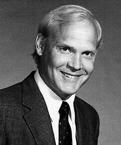 John C. Van Wagoner
received an M.S. and Ph.D. in stratigraphy from Rice University in Houston
in 1976 and 1977, respectively. His Ph.D. topic was the stratigraphic and
sedimentological analysis of mixed siliciclastic and carbonate strata in
the middle Pennsylvanian section of the Sacramento Mountains, New Mexico.
His dissertation advisor was Dr. James Lee Wilson. John joined Exxon Production
Research Company in November, 1976. With his facies background, he soon
became interested in facies analysis using well logs and cores. His early
work was in the Cotton Valley Formation of east Texas, where he described
over 15,000 feet of shallow-marine cores, mentored by C.V. Campbell. During
this time, John also worked in Honduras, the United Kingdom, and Africa.
In the early 1980s, encouraged
by Peter Vail and M.T. Jervey, John began to develop concepts of parasequences
and parasequence stacking patterns and their application to well-log correlation.
This approach had a major impact on how Exxon identified and mapped formations.
This work was strongly influenced by discussions with D.E. Frazier. Immediately
after M.T. Jervey formulated concepts of accommodation, John and an Exxon
team, including K.M. Campion, V.D. Rahmanian, and K.M. Bohacs, began to
develop techniques to identify sequences, sequence boundaries, and systems
tracts in outcrops, cores, and well logs. This work formed the basis for
sequence stratigraphic analyses using these types of data. Using this approach,
John has conducted more than 50 detailed studies of producing fields in
North America, Australia, Malaysia, and the North Sea. Many of the sequence
stratigraphy ideas developed by John and the Exxon team were based on field
work in the Book Cliffs of Utah and Colorado, the Powder River basin in
Wyoming, and the San Juan basin in New Mexico. Additionally, he has worked
extensively in the Brent and Statfjord Formations on both the U.K. and
Norwegian side of the North Sea.
John has taught at many Exxon
schools, including courses in sequence stratigraphy and facies analysis.
He has received outstanding instructor awards from Exxon on four occasions.
In addition, John has been
|
|
an AAPG Distinguished
Lecturer and has delivered AAPG short courses in Malaysia, Indonesia, and
Bahrain. He has conducted numerous workshops and has led universities on
field trips.
As well as many in-house
publications on stratigraphy and facies, he published AAPG Methods in
Exploration No. 7, Siliciclastic Sequence Stratigraphy in Well Logs, Cores,
and Outcrops. Along with his co-authors, he received the Robert Dott,
Sr., Award from the AAPG for this book in 1992. John has authored or edited
numerous technical papers and books on the subjects of sequence stratigraphy,
reservoir characterization, and facies analysis.
Currently, he is a Research
Advisor at Exxon Production Research Company charged with coordinating
technical work in the Reservoir Geometry and Continuity. He is actively
planning and conducting research and teaching.

George T. Bertram received
a B.Sc. Hon. in Geology and a Ph.D. in clastic sedimentology from Glasgow
University in Scotland. His research topic was the sedimentology of fine-grained
braided streams in Iceland. He joined Esso Exploration Europe Africa, Inc.
in 1978 as a geophysicist. With his sedimentological background and encouragement
from John Sangree and Robert Mitchum, Jr., he soon became interested in
seismic stratigraphy. His early interpretation experience was gained in
exploration projects in onshore African basins in Niger and Chad. After
a spell at Exxon Production Research Company in Houston, where he worked
in specialist research projects and training, he returned to Esso Exploration
to assist further in new venture exploration in Africa and Europe.
George moved to Britoil in
1983, where he built and taught the first internal seismic stratigraphy
course. He was also responsible for regional syntheses and basin study
projects in the North Sea and West of Shetlands. As part of Britoil's international
expansion, he lead a team studying and evaluating West African Basins. |



